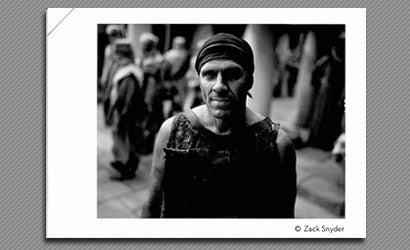Living Large
For film director Zack Snyder, the 4x5 format is a way of life.

There has always been a thin line between film and still photography for Hollywood phenom Zack Snyder. Director of last year’s hugely popular Greco-Persian war story 300, Snyder has been taking pictures for most of his life — inspired by the example of his mother, an artist/photographer who also planted the film seed by giving her son an 8mm movie camera when he was ten. “When I got out of college I started working as a director-cameraman for commercials,” says the photographer, a graduate of Pasadena’s Art Center College of Design. “I was using a Polaroid 3 1/4 x 4 1/4 pack-film camera as a way of checking exposure and previewing lighting, so I carried it with me wherever I went.”
Snyder went many places, spanning the globe to make music videos and Clio-winning commercials for clients such as Jeep, Budweiser, and Titleist, and shooting Polaroids as he traveled. Why Polaroids? “I look at a photograph as something like a sand castle,” he explains. “I like that it’s a one-off.” Snyder shoots Polaroid Type 55 black-and-white Positive/Negative film, as do many fine-art and documentary photographers, but unlike those photographers bravely throws his negative away.
With his first feature, Dawn of the Dead (a remake of the classic zombie film), on the horizon, Snyder was reading a 2001 story in American Photo about fashion photographer Bruce Weber’s use of the Littman 45 Single, a new camera designed for handheld 4×5 shooting. He bought one of the first Littmans off the line. The camera appealed to him not just because of its parallax-corrected rangefinder focusing — it is fundamentally a re-engineered, rebuilt Polaroid 110 — but by the bigger image it produced. “Shooting individual sheets of film was a bit of a deal, but the transition was really easy for me,” says Snyder. “The camera became second nature.”
Snyder has even used the camera for his commercial work, and not just for scouting purposes. One such occasion was for a CVS ad campaign he was directing; he used his Littman to shoot still portraits for the associated print advertisements. And for this job he shot color transparency film with the camera, an approach that called for especially careful metering and exposure. Though the Littman is a Polaroid by birth, it can shoot any wet-process 4×5 film or even accept a high-resolution digital back — important considerations given Polaroid’s recent decision to stop making instant films. Fuji, which already produces a variety of compatible instant films, will probably pick up the manufacturing slack, and Littman himself is angling for the license to make Type 55 Positive/Negative film.
Snyder has also shot stills on the sets of his own movies, including 300 and his upcoming Watchmen, now in postproduction. You can see some of this work in the accompanying gallery, reproduced from the original positive Polaroids. Ironically, it’s when he’s shooting on set that Snyder is most aware of the differences between photography and film. “A movie is moments that are strung together, whereas the camera allows me to take a moment on its own terms,” he explains. “It doesn’t have to relate to anything else.”
After Snyder wrapped up Watchmen he sent the camera back to its creator for an upgrade that turned it into a Littman VI, a more recent iteration that adds the unique, patent-pending ability to precisely adjust the parallelism of film and lens planes. “William kept it for quite a while, and I felt naked without it,” says the director, who also owns a Nikon D200 digital SLR. “I hadn’t realized how dependent I’d become on it.” It was worth the wait, though, because in the process Littman restyled Snyder’s camera into a spectacular designer model he dubbed the “Arabella.” Its owner seems to be unaware of its florid name, which is more likely a reference to Richard Strauss’s lyric opera than to Winston Churchill’s eccentric Buddhist granddaughter.
“It’s meant to evoke the Hollywood African adventure movies of the 1930s,” says Littman, who accented the camera with exotic Thuja burlwood (a “noble African wood,” he says) and decorated its focusing wheel with an African tribal shield. “I was going for a Johnny Weismuller-meets-Gatsby sort of thing.” Snyder is less descriptive. “It’s super cool, and gets a lot of attention when I’m walking around and shooting with it,” he says. “And now instead of keeping it in its Pelican case I put it on my bookcase because I like to look at it.” Cosmetics aside, Snyder reports that the upgrade has improved both viewfinder and focusing, and also makes the camera easier to hold securely, important given the slower shutter speeds his film speed often demands. “It was always super-reliable and pretty bulletproof,” he comments. “But now it’s just a little more effortless to operate.”
Despite its beauty and mechanical precision, the camera is also a throwback technically and mechanically — and that’s the way Snyder likes it. “It’s become my snapshot camera, so I had it with me when I was just on vacation in the Turks and Caicos,” says the director, whose upcoming movie, The Last Photograph, will be about a war photographer in Afghanistan. “I was walking on the beach and using close-up diopters to shoot weird stuff in the sand, using a tape measure to set the focus. This guy walks by and says, ‘You know, they’ve got that all figured out now, they have autofocus cameras.’ And I go, ‘Yeah, they want your soul too, so I think I’ll stay with this.'”